1996 TOYOTA TACOMA overheating
[x] Cancel search: overheatingPage 59 of 196
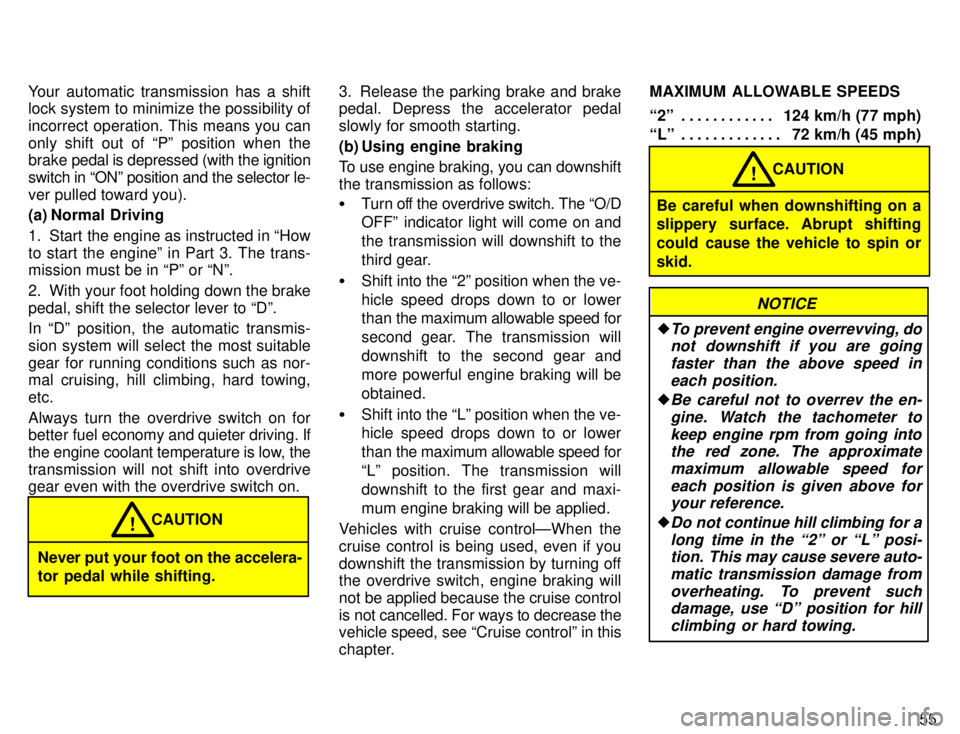
55
Your automatic transmission has a shift
lock system to minimize the possibility of
incorrect operation. This means you can
only shift out of Pº position when the brake
pedal is depressed (with the ignition
switch in ONº position and the selector le- ver pulled toward you).
(a) Normal Driving
1. Start the engine as instructed in How
to start the engineº in Part 3. The trans- mission must be in Pº or Nº.
2. With your foot holding down the brake
pedal, shift the selector lever to Dº.
In Dº position, the automatic transmis-
sion system will select the most suitable
gear for running conditions such as nor-
mal cruising, hill climbing, hard towing, etc.
Always turn the overdrive switch on for
better fuel economy and quieter driving. If
the engine coolant temperature is low, the transmission will not shift into overdrive
gear even with the overdrive switch on.
Never put your foot on the accelera-
tor pedal while shifting. CAUTION
! 3. Release the parking brake and brake
pedal. Depress the accelerator pedal
slowly for smooth starting.
(b) Using engine braking
To use engine braking, you can downshift the transmission as follows: �
Turn off the overdrive switch. The O/D
OFFº indicator light will come on and the transmission will downshift to the
third gear.
� Shift into the 2º position when the ve-
hicle speed drops down to or lower than the maximum allowable speed for
second gear. The transmission will downshift to the second gear andmore powerful engine braking will beobtained.
� Shift into the Lº position when the ve-
hicle speed drops down to or lower than the maximum allowable speed for
Lº position. The transmission will
downshift to the first gear and maxi-
mum engine braking will be applied.
Vehicles with cruise controlÐWhen the
cruise control is being used, even if you
downshift the transmission by turning off the overdrive switch, engine braking will
not be applied because the cruise control
is not cancelled. For ways to decrease the
vehicle speed, see Cruise controlº in this
chapter. MAXIMUM ALLOWABLE SPEEDS
2º 124 km/h (77 mph)
. . . . . . . . . . . .
Lº 72 km/h (45 mph) . . . . . . . . . . . . .
Be careful when downshifting on a
slippery surface. Abrupt shifting
could cause the vehicle to spin orskid. CAUTION
!
NOTICE
�To prevent engine overrevving, do
not downshift if you are going
faster than the above speed ineach position.
�Be careful not to overrev the en-
gine. Watch the tachometer tokeep engine rpm from going intothe red zone. The approximate
maximum allowable speed for each position is given above foryour reference.
�Do not continue hill climbing for a
long time in the 2º or Lº posi-tion. This may cause severe auto-
matic transmission damage fromoverheating. To prevent suchdamage, use Dº position for hill
climbing or hard towing.
Page 62 of 196
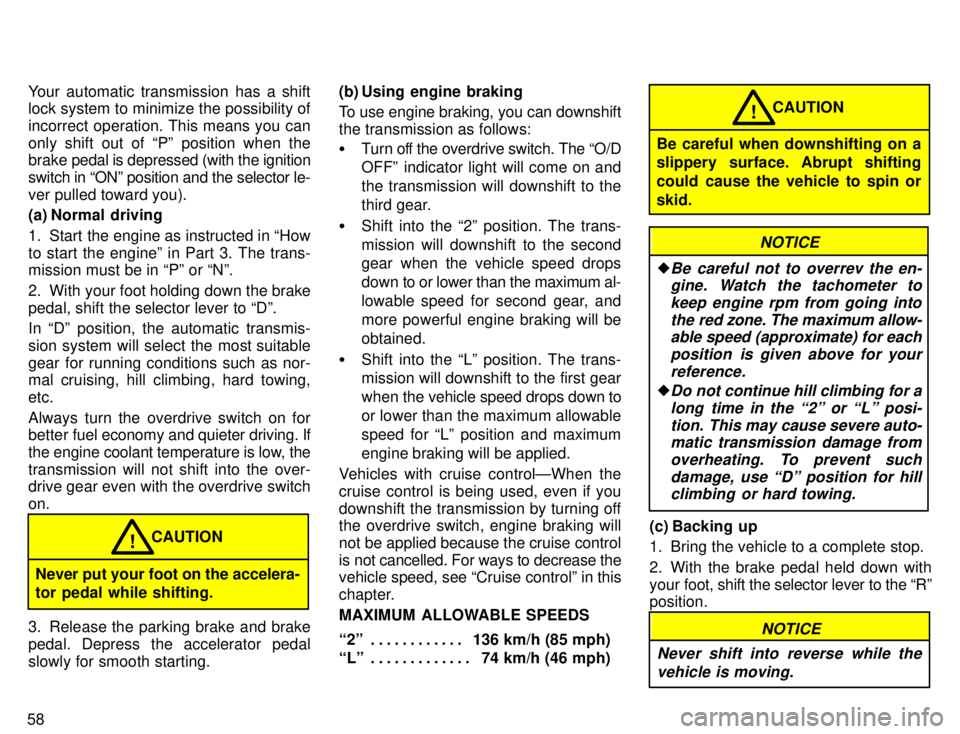
58Your automatic transmission has a shift
lock system to minimize the possibility of
incorrect operation. This means you can
only shift out of Pº position when the brake
pedal is depressed (with the ignition
switch in ONº position and the selector le- ver pulled toward you).
(a) Normal driving
1. Start the engine as instructed in How
to start the engineº in Part 3. The trans- mission must be in Pº or Nº.
2. With your foot holding down the brake
pedal, shift the selector lever to Dº.
In Dº position, the automatic transmis-
sion system will select the most suitable
gear for running conditions such as nor-
mal cruising, hill climbing, hard towing, etc.
Always turn the overdrive switch on for
better fuel economy and quieter driving. If
the engine coolant temperature is low, the transmission will not shift into the over-
drive gear even with the overdrive switch on.
Never put your foot on the accelera-
tor pedal while shifting. CAUTION
!
3. Release the parking brake and brake
pedal. Depress the accelerator pedal
slowly for smooth starting. (b) Using engine braking
To use engine braking, you can downshift the transmission as follows: �
Turn off the overdrive switch. The O/D
OFFº indicator light will come on and the transmission will downshift to the
third gear.
� Shift into the 2º position. The trans-
mission will downshift to the second
gear when the vehicle speed drops
down to or lower than the maximum al-
lowable speed for second gear, andmore powerful engine braking will beobtained.
� Shift into the Lº position. The trans- mission will downshift to the first gear
when the vehicle speed drops down to
or lower than the maximum allowable
speed for Lº position and maximum
engine braking will be applied.
Vehicles with cruise controlÐWhen the
cruise control is being used, even if you
downshift the transmission by turning off the overdrive switch, engine braking will
not be applied because the cruise control
is not cancelled. For ways to decrease the
vehicle speed, see Cruise controlº in this
chapter.
MAXIMUM ALLOWABLE SPEEDS
2º 136 km/h (85 mph) . . . . . . . . . . . .
Lº 74 km/h (46 mph) . . . . . . . . . . . . .
Be careful when downshifting on a
slippery surface. Abrupt shifting
could cause the vehicle to spin orskid. CAUTION
!
NOTICE
�Be careful not to overrev the en-
gine. Watch the tachometer to
keep engine rpm from going into
the red zone. The maximum allow-able speed (approximate) for each
position is given above for yourreference.
�Do not continue hill climbing for along time in the 2º or Lº posi-
tion. This may cause severe auto-matic transmission damage from
overheating. To prevent such damage, use Dº position for hillclimbing or hard towing.
(c) Backing up
1. Bring the vehicle to a complete stop.
2. With the brake pedal held down with your foot, shift the selector lever to the Rº
position.
NOTICE
Never shift into reverse while the vehicle is moving.
Page 66 of 196
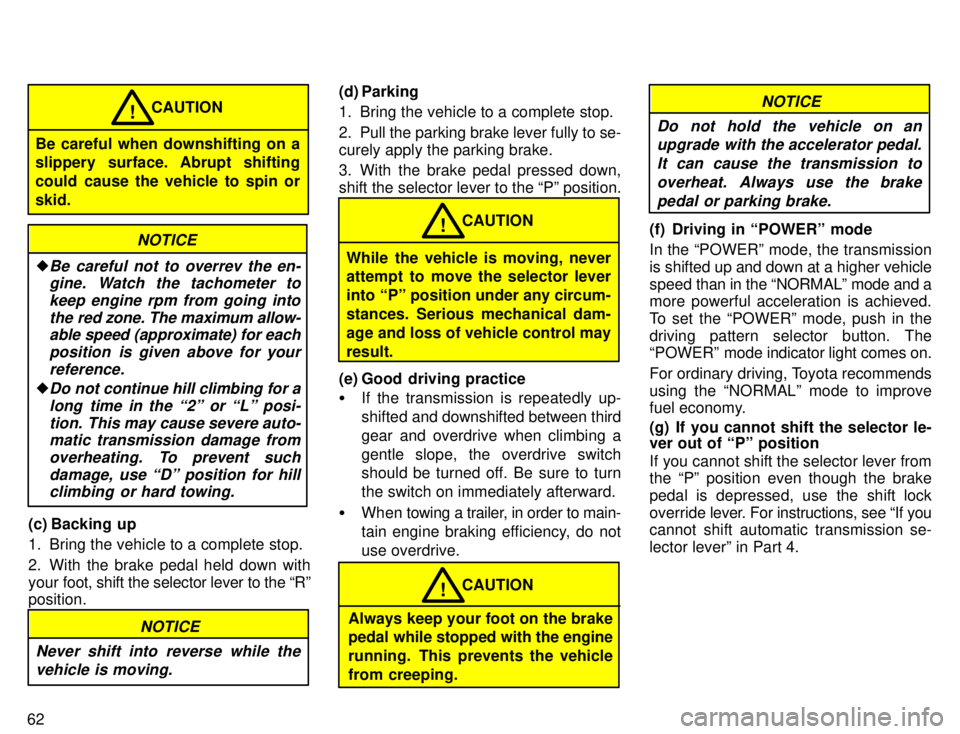
62
Be careful when downshifting on a
slippery surface. Abrupt shifting
could cause the vehicle to spin orskid.CAUTION
!
NOTICE
�Be careful not to overrev the en-
gine. Watch the tachometer to
keep engine rpm from going intothe red zone. The maximum allow-able speed (approximate) for each
position is given above for yourreference.
�Do not continue hill climbing for a
long time in the 2º or Lº posi-tion. This may cause severe auto-matic transmission damage from
overheating. To prevent such damage, use Dº position for hillclimbing or hard towing.
(c) Backing up
1. Bring the vehicle to a complete stop.
2. With the brake pedal held down with your foot, shift the selector lever to the Rº
position.
NOTICE
Never shift into reverse while the vehicle is moving.
(d) Parking
1. Bring the vehicle to a complete stop.
2. Pull the parking brake lever fully to se- curely apply the parking brake.
3. With the brake pedal pressed down,
shift the selector lever to the Pº position.
While the vehicle is moving, never
attempt to move the selector lever
into Pº position under any circum-
stances. Serious mechanical dam-
age and loss of vehicle control mayresult. CAUTION
!
(e) Good driving practice � If the transmission is repeatedly up-
shifted and downshifted between third
gear and overdrive when climbing a
gentle slope, the overdrive switch
should be turned off. Be sure to turn the switch on immediately afterward.
� When towing a trailer, in order to main-
tain engine braking efficiency, do notuse overdrive.
Always keep your foot on the brake
pedal while stopped with the engine
running. This prevents the vehicle
from creeping. CAUTION
!
NOTICE
Do not hold the vehicle on an upgrade with the accelerator pedal.
It can cause the transmission tooverheat. Always use the brake pedal or parking brake.
(f) Driving in POWERº mode In the POWERº mode, the transmission
is shifted up and down at a higher vehicle
speed than in the NORMALº mode and a
more powerful acceleration is achieved.
To set the POWERº mode, push in the
driving pattern selector button. The
POWERº mode indicator light comes on.
For ordinary driving, Toyota recommends
using the NORMALº mode to improve
fuel economy.
(g) If you cannot shift the selector le-
ver out of Pº position
If you cannot shift the selector lever from the Pº position even though the brake
pedal is depressed, use the shift lock
override lever. For instructions, see If you
cannot shift automatic transmission se-lector leverº in Part 4.
Page 115 of 196
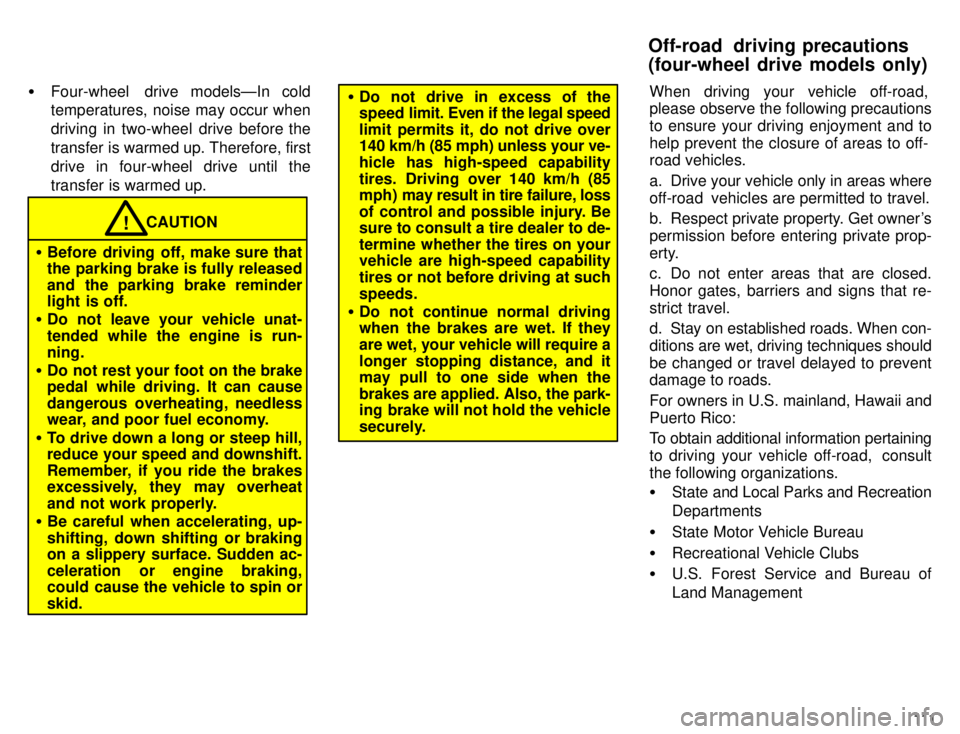
111
�
Four-wheel drive modelsÐIn cold
temperatures, noise may occur when
driving in two-wheel drive before the
transfer is warmed up. Therefore, first
drive in four-wheel drive until the
transfer is warmed up.
CAUTION
� Before driving off, make sure that
the parking brake is fully released
and the parking brake reminder
light is off.
� Do not leave your vehicle unat- tended while the engine is run-ning.
� Do not rest your foot on the brake
pedal while driving. It can cause
dangerous overheating, needless
wear, and poor fuel economy.
� To drive down a long or steep hill,reduce your speed and downshift.
Remember, if you ride the brakes
excessively, they may overheat
and not work properly.
� Be careful when accelerating, up-
shifting, down shifting or braking on a slippery surface. Sudden ac-
celeration or engine braking,
could cause the vehicle to spin or skid.!
�Do not drive in excess of the
speed lim it. Even if the legal speed
limit permits it, do not drive over
140 km/h (85 mph) unless your ve-
hicle has high-speed capability
tires. Driving over 140 km/h (85
mph) may result in tire failure, loss
of control and possible injury. Be
sure to consult a tire dealer to de-
termine whether the tires on your vehicle are high-speed capability tires or not before driving at suchspeeds.
� Do not continue normal driving
when the brakes are wet. If they
are wet, your vehicle will require a
longer stopping distance, and it
may pull to one side when the brakes are applied. Also, the park-
ing brake will not hold the vehicle
securely. When driving your vehicle off-road,
please observe the following precautions
to ensure your driving enjoyment and to
help prevent the closure of areas to off-
road vehicles.
a. Drive your vehicle only in areas where
off-road vehicles are permitted to travel.
b. Respect private property. Get owner's
permission before entering private prop-
erty.
c. Do not enter areas that are closed.
Honor gates, barriers and signs that re-
strict travel.
d. Stay on established roads. When con- ditions are wet, driving techniques should
be changed or travel delayed to prevent
damage to roads.
For owners in U.S. mainland, Hawaii and Puerto Rico:
To obtain additional information pertaining
to driving your vehicle off-road, consultthe following organizations. �
State and Local Parks and Recreation Departments
� State Motor Vehicle Bureau
� Recreational Vehicle Clubs
� U.S. Forest Service and Bureau of
Land Management
Off-road driving precautions(four-wheel drive models only)
Page 121 of 196
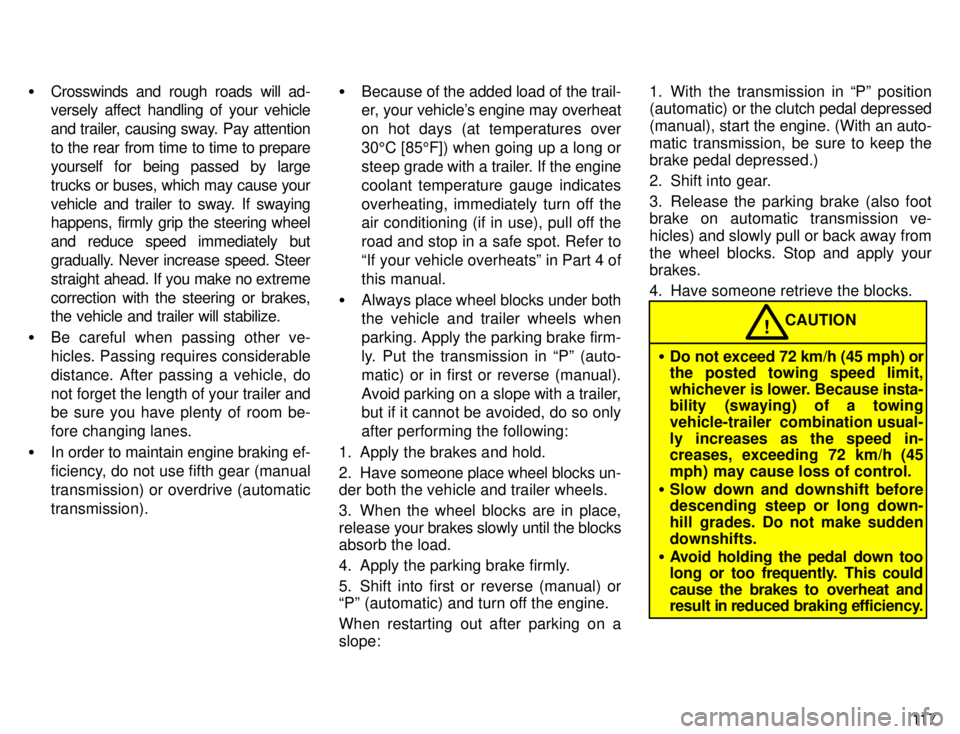
11 7
�
Crosswinds and rough roads will ad-
versely affect handling of your vehicle
and trailer, causing sway. Pay attention
to the rear from time to time to prepare
yourself for being passed by large
trucks or buses, which may cause your
vehicle and trailer to sway. If swaying
happens, firmly grip the steering wheel
and reduce speed immediately but
gradually. Never increase speed. Steer
straight ahead. If you make no extreme
correction with the steering or brakes,
the vehicle and trailer will stabilize.
� Be careful when passing other ve- hicles. Passing requires considerable
distance. After passing a vehicle, do
not forget the length of your trailer and
be sure you have plenty of room be-
fore changing lanes.
� In order to maintain engine braking ef-
ficiency, do not use fifth gear (manual
transmission) or overdrive (automatictransmission). �
Because of the added load of the trail-
er, your vehicle's engine may overheat
on hot days (at temperatures over30 5C [85 5F]) when going up a long or
steep grade with a trailer. If the engine
coolant temperature gauge indicates
overheating, immediately turn off the
air conditioning (if in use), pull off the
road and stop in a safe spot. Refer to
If your vehicle overheatsº in Part 4 ofthis manual.
� Always place wheel blocks under both
the vehicle and trailer wheels whenparking. Apply the parking brake firm-
ly. Put the transmission in Pº (auto-
matic) or in first or reverse (manual).
Avoid parking on a slope with a trailer, but if it cannot be avoided, do so only after performing the following:
1. Apply the brakes and hold.
2. Have someone place wheel blocks un-
der both the vehicle and trailer wheels.
3. When the wheel blocks are in place,
release your brakes slowly until the blocks
absorb the load.
4. Apply the parking brake firmly.
5. Shift into first or reverse (manual) or
Pº (automatic) and turn off the engine. When restarting out after parking on a slope: 1. With the transmission in Pº position
(automatic) or
the clutch pedal depressed
(manual), start the engine. (With an auto-
matic transmission, be sure to keep thebrake pedal depressed.)
2. Shift into gear.
3. Release the parking brake (also foot
brake on automatic transmission ve-
hicles) and slowly pull or back away from
the wheel blocks. Stop and apply your brakes.
4. Have someone retrieve the blocks.
� Do not exceed 72 km/h (45 mph) or
the posted towing speed limit,
whichever is lower. Because insta-
bility (swaying) of a towing
vehicle-trailer combination usual-
ly increases as the speed in-
creases, exceeding 72 km/h (45
mph) may cause loss of control.
� Slow down and downshift before
descending steep or long down-
hill grades. Do not make suddendownshifts.
� Avoid holding the pedal down too
long or too frequently. This could
cause the brakes to overheat and
result in reduced braking efficiency.
CAUTION!
Page 122 of 196
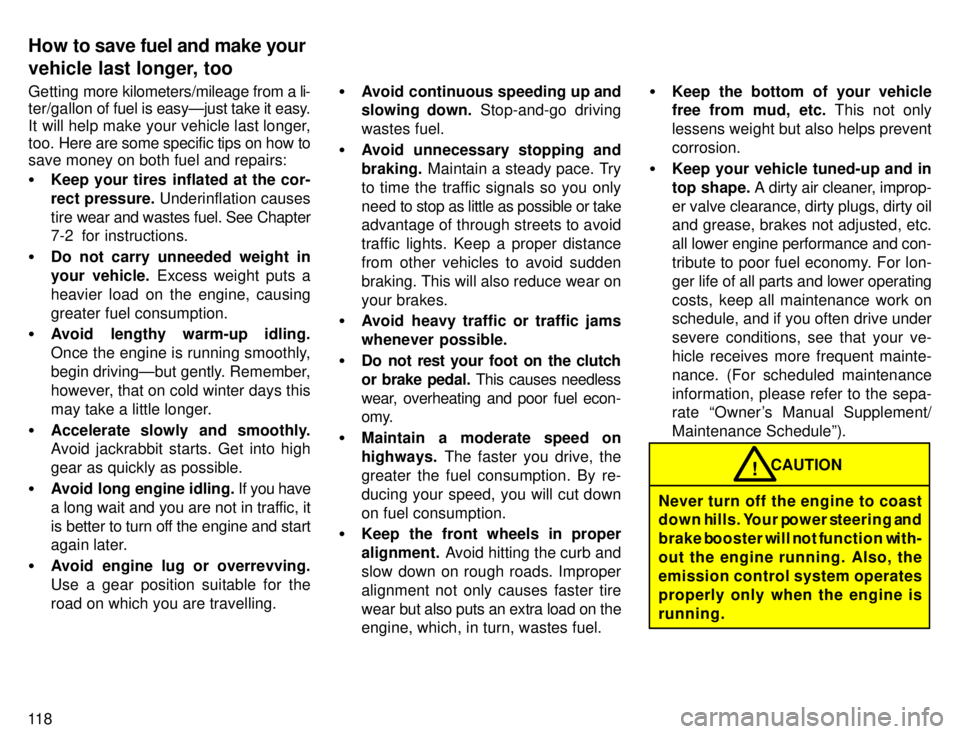
11 8Getting
more kilometers/mileage from a li-
ter/gallon of fuel is easyÐjust take it easy.
It will help make your vehicle last longer,
too. Here are some specific tips on how to
save money on both fuel and repairs: � Keep your tires inflated at the cor- rect pressure. Underinflation causes
tire wear and wastes fuel. See Chapter
7-2 for instructions.
� Do not carry unneeded weight in
your vehicle. Excess weight puts a
heavier load on the engine, causinggreater fuel consumption.
� Avoid lengthy warm-up idling.
Once the engine is running smoothly,
begin drivingÐbut gently. Remember,
however, that on cold winter days this
may take a little longer.
� Accelerate slowly and smoothly.
Avoid jackrabbit starts. Get into high
gear as quickly as possible.
� Avoid long engine idling. If you have
a long wait and you are not in traffic, it
is better to turn off the engine and start
again later.
� Avoid engine lug or overrevving.
Use a gear position suitable for the
road on which you are travelling. �
Avoid continuous speeding up and
slowing down. Stop-and-go driving
wastes fuel.
� Avoid unnecessary stopping and braking. Maintain a steady pace. Try
to time the traffic signals so you only
need to stop as little as possible or take
advantage of through streets to avoid
traffic lights. Keep a proper distance
from other vehicles to avoid suddenbraking. This will also reduce wear onyour brakes.
� Avoid heavy traffic or traffic jams
whenever possible.
� Do not rest your foot on the clutch
or brake pedal. This causes needless
wear, overheating and poor fuel econ-
omy.
� Maintain a moderate speed on highways. The faster you drive, the
greater the fuel consumption. By re-
ducing your speed, you will cut down
on fuel consumption.
� Keep the front wheels in properalignment. Avoid hitting the curb and
slow down on rough roads. Improper
alignment not only causes faster tire
wear but also puts an extra load on the
engine, which, in turn, wastes fuel. �
Keep the bottom of your vehicle
free from mud, etc. This not only
lessens weight but also helps prevent corrosion.
� Keep your vehicle tuned-up and in
top shape. A dirty air cleaner, improp-
er valve clearance, dirty plugs, dirty oil
and grease, brakes not adjusted, etc.
all lower engine performance and con-
tribute to poor fuel economy. For lon-
ger life of all parts and lower operating
costs, keep all maintenance work on
schedule, and if you often drive under severe conditions, see that your ve-
hicle receives more frequent mainte-nance. (For scheduled maintenance
information, please refer to the sepa-
rate Owner's Manual Supplement/
Maintenance Scheduleº).
CAUTION
Never turn off the engine to coast
down hills. Your power steering and
brake booster will not function with-
out the engine running. Also, the
emission control system operates
properly only when the engine is
running.!
How to save fuel and make your
vehicle last longer, too
Page 126 of 196
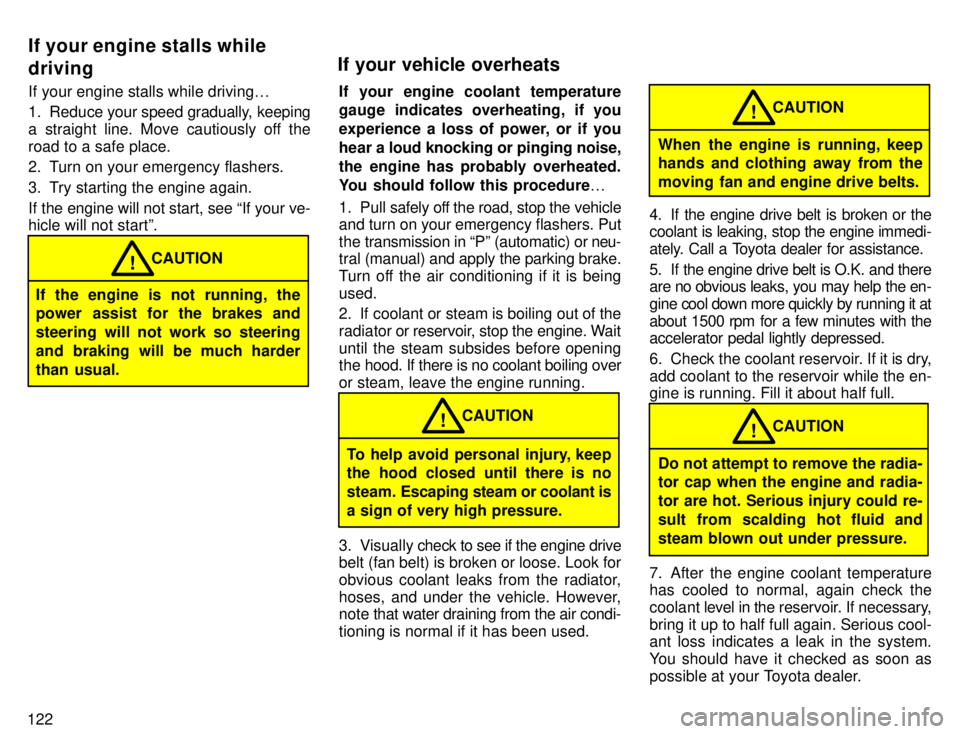
122If your engine stalls while driving
0
1. Reduce your speed gradually, keeping
a straight line. Move cautiously off the
road to a safe place.
2. Turn on your emergency flashers.
3. Try starting the engine again.
If the engine will not start, see If your ve-
hicle will not startº.
If the engine is not running, the
power assist for the brakes and
steering will not work so steering
and braking will be much harder
than usual. CAUTION
! If your engine coolant temperature
gauge indicates overheating, if you
experience a loss of power, or if you
hear a
loud knocking or pinging noise,
the engine has probably overheated.
You should follow this procedure 0
1. Pull safely off the road, stop the vehicle
and turn on your emergency flashers. Put
the transmission in Pº (automatic) or neu-
tral ( manual) and apply the parking brake.
Turn off the air conditioning if it is beingused.
2. If coolant or steam is boiling out of the
radiator or reservoir, stop the engine. Wait
until the steam subsides before opening
the hood. If there is no coolant boiling over or steam, leave the engine running.
To help avoid personal injury, keep
the hood closed until there is no steam. Escaping steam or coolant is
a sign of very high pressure. CAUTION
!
3. Visually check to see if the engine drive
belt (fan belt) is broken or loose. Look for
obvious coolant leaks from the radiator,
hoses, and under the vehicle. However, note that water draining from the air condi-
tioning is normal if it has been used.
When the engine is running, keep
hands and clothing away from the
moving fan and engine drive belts. CAUTION
!
4. If the engine drive belt is broken or the
coolant is leaking, stop the engine immedi-
ately. Call a Toyota dealer for assistance.
5. If the engine drive belt is O.K. and there
are no obvious leaks, you may help the en-
gine cool down more quickly by running it at
about 1500 rpm for a few minutes with the
accelerator pedal lightly depressed.
6. Check the coolant reservoir. If it is dry,
add coolant to the reservoir while the en- gine is running. Fill it about half full.
Do not attempt to remove the radia-
tor cap when the engine and radia-
tor are hot. Serious injury could re-
sult from scalding hot fluid and
steam blown out under pressure. CAUTION
!
7. After the engine coolant temperature
has cooled to normal, again check the
coolant level in the reservoir. If necessary,
bring it up to half full again. Serious cool- ant loss indicates a leak in the system.
You should have it checked as soon as
possible at your Toyota dealer.
If your engine stalls while
driving
If your vehicle overheats